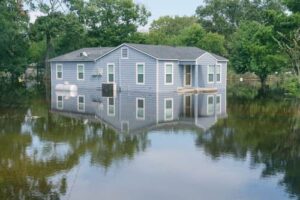Best flood insurance companies of 2024
The best flood insurance company for you depends on how you prefer to purchase your coverage. It's a good idea to look at both private flood insurance companies and companies that participate in the WYO program.
However, private flood companies can't be compared directly with WYO companies since what they offer is different. We've therefore broken down our best flood insurance companies lists into two categories.
The best private flood insurance companies
To identify the best companies for private flood insurance, our editorial team looked at coverage options, waiting periods, geographic availability and rates, where available. The editors then selected our top choices from a list of private flood insurance companies for various needs after a careful review of these metrics. Since rates are not available for every company, only those for which we have rates were considered for the cheapest company category.
Best overall: Neptune
Neptune earned the top spot overall for good coverage limits and various options, a reasonable waiting period of ten days (no waiting period on loan closing), and, perhaps most importantly, nationwide availability.
Neptune’s flood insurance offers:
- Dwelling coverage up to $4 million
- Personal property of up to $500,000
- Available contents replacement cost coverage
- Additional living expenses coverage at $100/day up to $10,000
- Basement coverage up to $10,000
- Other structures coverage up to $50,000
- Pool coverage up to $10,000
Neptune writes flood insurance in all 50 states.
Best for cheap rates: Palomar
Palomar flood insurance offers the cheapest average rates for flood insurance among the companies for which we were able to get rate information. At an average of $390 a year, Palomar’s flood insurance rates are below the average estimated flood insurance rate even for the NFIP, which is around $700 a year.
Palomar offers:
- Dwelling coverage of up to $5 million
- Contents coverage of up to $1 million
- Additional living expenses up to $50,000
- Optional replacement cost coverage for personal property
Coverage is available in 30 states, including Florida, and there is no waiting period.
Best for high-value homes: Chubb
Chubb is known for providing homeowners insurance for high-value homes, and it also offers the best flood insurance for those homes with the highest dwelling coverage maximum of any company we considered by a wide margin.
Coverage limits include:
- Combined limits for dwelling and personal property of up to $15 million
- Replacement cost coverage for personal property included
- Additional living expenses included at $7,500 with higher limits optional
- Coverage for basements
- Add-ons, including higher valuables limits
Chubb’s average flood insurance rate is $1,117 a year but may be much higher for high coverage limits.
Best for a well-known company: National General, an Allstate company
If you want your flood insurance backed by a well-known insurance company, National General fits the bill. A subsidiary of Allstate, National General offers private flood insurance in 30 states. Coverage options include:
- Dwelling coverage of up to $1.5 million
- Additional living expenses coverage up to $150,000
- Basement and pool coverage available
National General also has low rates, with an average cost of $622 a year, and has no waiting period at all for coverage in Florida and New Jersey, no waiting period on loan closing in all other states, and a seven-day waiting period for all other applications.
Best for Florida: Kin
Kin offers flood insurance in Florida as an endorsement on its home insurance policy. With the home insurance market in Florida struggling, finding a company that will provide all of the hurricane insurance coverage you need in one place makes life a lot easier, and Kin does just that.
Kin’s flood insurance will cover:
- Dwelling up to the home insurance policy limits
- Personal property up to the home policy limits
- Replacement cost coverage
- A detached garage
Kin states that its average flood insurance policy in Zone X (moderate-to-low risk) costs as little as $175 a year. Rates will be higher in high-risk zones. There’s no waiting period for a flood policy from Kin, allowing Florida residents to get the coverage they need fast.
The best flood insurance companies for NFIP policies
A number of major companies participate in the NFIP’s Write-Your-Own flood insurance program. While rates and coverage through these companies are the same as if you bought the policy directly, your policy will be serviced by your chosen company. That means it’s important to choose a company with a good reputation. We started with the full Write Your Own flood insurance company list and then narrowed it down.
Below, we’ve listed flood insurance companies that have a great reputation for customer service, based on the National Association of Insurance Commissioners (NAIC) customer complaint ratio. All of these companies offer coverage in every state as well as D.C. We have also noted whether or not the company also writes home insurance for those seeking the convenience of one-stop shopping.
| Company | NAIC complaint ratio | Home insurance available |
|---|---|---|
| Wright Flood | 0 | No |
| PURE Insurance | 0.19 | Yes |
| Philadelphia Indemnity | 0.21 | No |
| Hartford Insurance Company | 0.38 | Yes |
| Liberty Mutual | 1.12 | Yes |
The following major home insurance companies also offer NFIP policies for one-stop home insurance shopping:
- Allstate
- American Family
- Auto-Owners
- CSAA
- Farmers
- USAA
Shopping for flood insurance
Flood damage is not covered by home insurance, so flood insurance is a must for many people. It’s important to do a careful evaluation of your flood insurance needs before you start shopping.
If you’re in a high-risk area, your mortgage company will probably require you to buy flood insurance. But don’t assume that you don’t need it if your mortgage company doesn’t require it. The NFIP estimates that more than 25% of flood claims are filed in locations outside of high-risk flood zones. It’s the most common natural disaster in the U.S.
In other words, more people should be buying flood insurance. To get started, gather some quotes and compare rate quotes and coverage from both NFIP-backed policies and private flood insurance companies to see what you’ll get for your money.
"[People should] check whether the extra premium for private flood insurance is reasonable, whether the coverage is actual cash value based, or replacement cost based, or agreed value. They also need to check whether private flood insurance is available for their special area. They can also check whether there are discounts available to lower the premiums they pay," says Haibo (Stephen) Yao, assistant professor of insurance and risk management at Central Arkansas University.
For many people who have never purchased flood insurance, it’s a good idea to sit down with an agent or broker to discuss the type of policy you need.
How much flood insurance do you need?
If you are required to have flood insurance, your mortgage company will let you know how much coverage you need. You’ll likely be required to carry at least the property development cost, which is the cost to rebuild your home, or the maximum amount of coverage, whichever is lower.
You’re not required to cover your personal property, but flood insurance includes personal property coverage.
Whether or not you’re required to buy a policy, the replacement cost of your home and the value of your possessions is a good rule of thumb. Bear in mind that NFIP flood insurance policies have limits on coverage, so if you need more, you’ll want to shop with private companies.
Who provides most flood insurance?
The majority of flood insurance policies in the U.S. are underwritten by the NFIP, either directly or through the WYO program. Although WYO policies are sold through private insurance companies, they are still NFIP policies.
What’s the difference between NFIP and private flood insurance?
NFIP policies have specific limits on coverage. The maximum replacement cost coverage for your house with an NFIP policy is $250,000, and the maximum personal property coverage is $100,000. There is a combined limit of $2,500 on specific types of personal property (fine art, jewelry, collectibles, furs and business property.)
"NFIP only offers Actual Cash Value (ACV) coverage on your personal property and on attached property. While private flood insurance may provide the same coverage at a replacement cost basis, which will save more money for those policyholders," Yao says.
NFIP policies do not include loss of use, or additional living expenses coverage, which pays for extra expenses when you can’t live at home after a flood.
Private flood insurance doesn’t have these limitations and offers higher coverage limits along with more options. Pricing is also more varied with private flood insurance, while NFIP rates are set.
Methodology
Insurance.com gathered coverage details on flood insurance policies from private flood insurance companies and then looked at NAIC rate data to calculate average rates, dividing direct written premiums by the number of policies in force at the end of the year for each carrier listed, where available. Note that some carriers' average rates include rates for policy endorsements as well as standalone policies. We then analyzed each company’s offerings, waiting period and geographical availability and our editors made the final decision on the top companies for specific needs.
To compare NFIP Write-Your-Own insurance companies, we started with the list of companies provided by FEMA, and then narrowed down our choices to companies available in all 50 states and D.C. and ranked them by NAIC scores.







